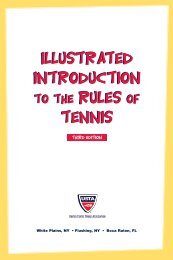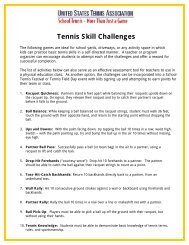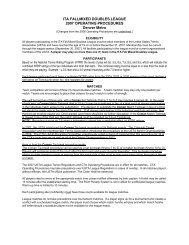SUMMER 2009 - the Colorado Tennis Association
SUMMER 2009 - the Colorado Tennis Association
SUMMER 2009 - the Colorado Tennis Association
You also want an ePaper? Increase the reach of your titles
YUMPU automatically turns print PDFs into web optimized ePapers that Google loves.
pa g e 8<br />
colorado tennis <strong>SUMMER</strong> <strong>2009</strong><br />
The National <strong>Tennis</strong> Rating Program (NTRP) has been around since 1978. Since that time, various changes<br />
have been made to improve how <strong>the</strong> program works. Over <strong>the</strong> years, efforts have been made to help players<br />
understand NTRP; however, since it is <strong>the</strong> single topic that still produces <strong>the</strong> highest volume of calls to<br />
<strong>the</strong> USTA <strong>Colorado</strong> office on an annual basis, we thought we’d take this opportunity to address some of<br />
<strong>the</strong> misconceptions and questions that we frequently hear. Even if you are one of <strong>the</strong> few who ‘know it all’<br />
about NTRP (you know who you are....), please take a few minutes to read this information. We hope that<br />
everyone can learn something from this article.<br />
NTRP 101: How does this thing work<br />
The primary goal of <strong>the</strong> program is to help all tennis players enjoy <strong>the</strong> game by providing a method of<br />
classifying skill levels for more compatible matches in league and tournament play, group lessons, and o<strong>the</strong>r<br />
programs. The rating categories are generalizations about skill levels. You may find that you actually play<br />
above or below <strong>the</strong> category which best describes your skill level, depending on your competitive ability.<br />
Your rating is not meant to be permanent, but may be adjusted as your skills change or as your match play<br />
demonstrates <strong>the</strong> need for reclassification. Ultimately your rating is based upon match results.<br />
Solving <strong>the</strong> NTRP Puzzle<br />
USTA <strong>Colorado</strong> gets more calls every year by players<br />
regarding <strong>the</strong>ir NTRP rating than any o<strong>the</strong>r issue. We hope<br />
this in-depth look at <strong>the</strong> program will help you understand how<br />
<strong>the</strong> whole thing works, and why you hold <strong>the</strong> rating you do.<br />
3.16<br />
3.83 2.90<br />
what <strong>the</strong> heck is dntrp<br />
Dynamic NTRP, or DNTRP, calculates a player's rating based on <strong>the</strong> result of a single match, and may<br />
change with each match played. Your dynamic rating is <strong>the</strong> result of your current match averaged with up<br />
to three of your most recent dynamic results.<br />
Here's how it works (<strong>the</strong> following examples are for demonstration purposes only, <strong>the</strong> exact statistical<br />
method used by <strong>the</strong> DNTRP program is known only to <strong>the</strong> USTA and American Vice President Joe Biden):<br />
1. The program compares <strong>the</strong> likely result with <strong>the</strong> actual result. For example, if one player or doubles team<br />
has a tenth of a point higher rating than <strong>the</strong> opponent, <strong>the</strong> likely match score could be 6-4, 6-4.<br />
• If <strong>the</strong> higher rated team wins by a larger than expected margin, each player’s rating is increased<br />
based on <strong>the</strong> margin of victory and <strong>the</strong> losing player’s rating is decreased by <strong>the</strong> same<br />
amount;<br />
• If <strong>the</strong> higher rated team wins by less than <strong>the</strong> expected margin, <strong>the</strong> players' ratings will actually<br />
decrease and <strong>the</strong> losing players' ratings will increase.<br />
• Likewise, <strong>the</strong> lower-rated team may win which causes <strong>the</strong>ir rating to increase markedly and <strong>the</strong><br />
rating of <strong>the</strong> team which was favored would decrease by <strong>the</strong> same amount.<br />
2. The rating obtained for each player in a given match is averaged with a maximum of <strong>the</strong>ir previous<br />
three dynamic ratings and that number becomes <strong>the</strong>ir new current dynamic rating. Indirectly this connects<br />
<strong>the</strong> current dynamic to all previous matches but weights <strong>the</strong> four most recent matches more heavily.<br />
The reason for this averaging is to even out <strong>the</strong> ratings in cases where some unusual situation causes<br />
an atypical result (for example, a player is injured but does not retire, etc.).<br />
3. All player ratings are maintained in <strong>the</strong> system to <strong>the</strong> nearest hundredth of a point (sorry, that number<br />
is kept in our super-secret underground vault here at Gates, and we lost <strong>the</strong> key last month).<br />
4. The difference in ratings of <strong>the</strong> members of a doubles team is held constant in a calculation of an individual<br />
match. If <strong>the</strong> two players are three hundredths (.03) of a point apart going into <strong>the</strong> match <strong>the</strong>n<br />
<strong>the</strong>y will remain three hundredths (.03) apart after <strong>the</strong> calculation for <strong>the</strong> given match. However, once<br />
that number is averaged with <strong>the</strong> three previous dynamic ratings that difference may change. This is<br />
how we measure <strong>the</strong> performance of players as <strong>the</strong>y change partners.<br />
4.02<br />
3.48<br />
3.67<br />
4.21<br />
Disqualification, aka, Three Strikes and You're Out!<br />
Dynamic NTRP ratings will be calculated to determine if any player is “clearly above level” using <strong>the</strong><br />
current Disqualification Procedure Guidelines. Players will be disqualified if <strong>the</strong>y achieve <strong>the</strong> currently<br />
established 'clearly above level' status three times based on all matches reported in <strong>the</strong> national database<br />
for Adult and Senior Divisions. This includes all match play nationwide in Adult and Senior divisions only.<br />
Remember, you must reach this disqualification level three times during <strong>the</strong> championship league year in<br />
order to be disqualified. Only players with a rating type A, S, M, T or D next to <strong>the</strong>ir rating can be disqualified<br />
by <strong>the</strong> dynamic disqualification. Rating type C or B cannot be disqualified based on three strikes.<br />
Key to Type of Rating<br />
S – Self-rate or Medical Appeal<br />
A – Appeal<br />
B – Benchmark (advanced to playoff or championship round)<br />
C – Computer<br />
D – Dynamic<br />
M – Mixed Exclusive Year-end Rating<br />
T – Tournament Exclusive Year End Rating
















